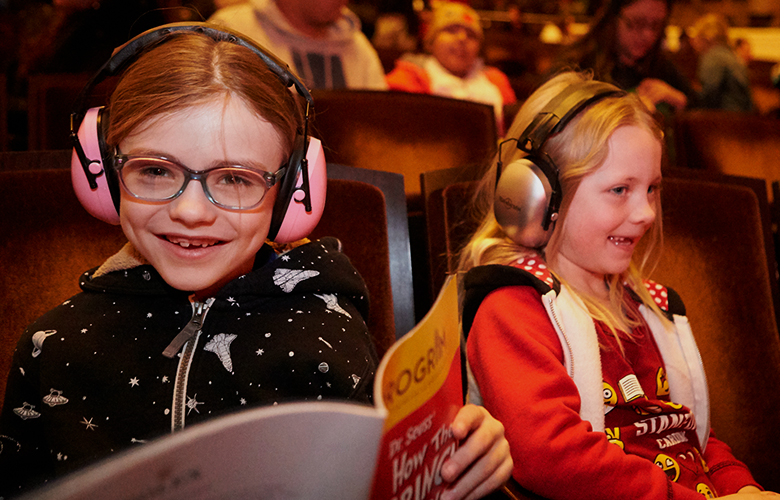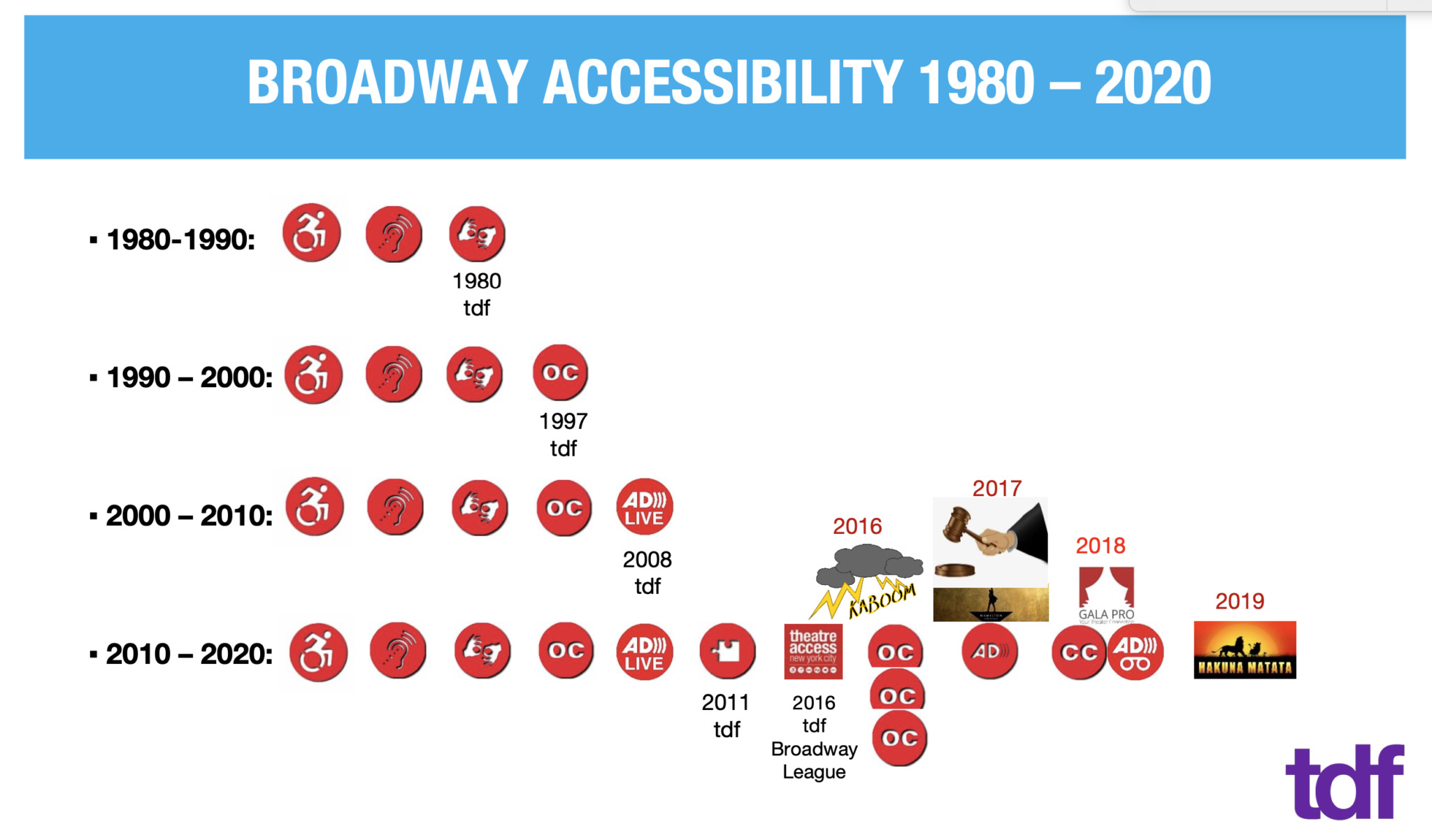
In 2020/2021, TheatreArtLife embarked on a series on Accessibility in Theatre. We reached out to people and companies across multiple continents, wrote articles, held webinars and a whole lotta zoom sessions. In doing so, we have learned so much and yet not nearly enough. We now know this “series” is not something we can just feature and move on to the next topic. Accessibility needs to be woven into the fabric of our arts community, just like diversity. There is much to be done. Here is what we have learned so far:
When I met Lisa Carling, director of TDF Accessibility Programs, I learned how much had been done to make arts accessible for audiences. In fact, if you take a look at the graphic below, you will see how far Broadway has come in terms of accessibility since 1980.

Now with apps such as GALA PRO, audiences can have access to multilingual subtitles, closed captioning, dubbing, audio description and amplification. Around the world, theatre companies and venues are working to provide opportunities for anyone to enjoy theatre. For those who have the money, it can be an app like Gala Pro. For others, it is simply by providing some sensory friendly performances, offering audio description or having a person doing sign language for the deaf or hard of hearing.
Here are some quick definitions for those not well versed in accessibility terms:
Closed Captioning – Closed Captioning is a text version of the speech in a show to help deaf or hard of hearing people. Closed captioning includes description of background sounds and speaker changes.
Subtitles – Are similar to closed captions but subtitles assume the viewer hears the audio and needs to understand only the words that are being spoken. This is used more for translation than for deaf / hard of hearing audiences.
Audio Description – Audio description describes the scenes of the show and what is happening visually for those who are blind or have low vision.
Amplification – Amplification in an accessibility sense, allows people to plug into a device that allows them to turn up the volume on what they are hearing. This allows people who are hard of hearing to hear dialogue onstage better.
Sensory Friendly – Sensory friendly shows are a more relaxed version of a traditional performance to allow people with sensory sensitivity to enjoy the show with their families. Often this will mean the show will do the following to accommodate audiences:
Unlike audiences, accessibility in the performing and technical realms, ie: arts workers, still has a long way to go. Yes, there are people in our industry with accessibility needs, but they are not there because we have paved a path for them, they are there out of sheer grit and determination to be in this industry. There are companies out there making an effort and there are companies like Touch Compass that are by choice, disability lead. But, these are outliers, and there is still a long way to go.
If anyone is to have a career in the arts, they need opportunities for them to build their knowledge and experience from the beginning. This begins where all of us start in the arts; in schools, universities, at local theatres and in the community. Most of the people I spoke to who have accessibility needs have one or two horror stories to tell about the barriers to their education and the hurdles to getting their opportunities. Often these barriers and hurdles are not put up out of any ill wish towards those with access needs, but more due to those institutions not understanding or knowing what to do. More education and advocacy is needed in our artistic community.
When I interviewed my friend Peter Royston, who has cerebral palsy, about working in the arts, he made a statement that has stayed with me ever since our webinar together. He said “Everyone has accessibility needs, just some more than others”. It’s so true. How many times as a stage manager have I asked an artist or technician if they had everything they needed? Why can’t we expand that question to be a little larger and do a little more to make those with accessibility needs more comfortable?
We label people. We classify our children as “on the spectrum” or “deaf” or “physically disabled” and in doing so we automatically make assumptions on what they can and cannot do. We need to challenge our own thinking on this. We need to not put this community in boxes.
There are many people out there who are navigating the world with barriers and pathways that able bodied and neuro-typical people don’t see or understand. These people have a unique view of the world. These people have a different perspective, a different mindset and a different set of gifts to offer the theatre and artistic world. And isn’t that what art is all about? Looking at the world in different ways. The arts community has a responsibility to lead the way. What is onstage is a reflection of our society. How can we reflect society if we don’t tell all the stories and include all of humanity in that spectrum?
We can. We just need to open that door…..
And provide the ramp.
When Sailors Were Stagehands – Debunking a Bit of Rigging History
Popcorn – A History of That Little Extra Bite of Entertainment


Anna Robb is Co-Founder and Managing Director for TheatreArtLife. Anna is an experienced Producer/Production Stage Manager. Her 20-year work history spans Asia Pacific, the Americas, Africa, the Middle East and Europe. She has worked for companies such as Cirque du Soleil, Franco Dragone Entertainment Group, Christie Digital Systems and The Sydney Opera House. Anna was an integral part of the research and development, training and formation, creation and operation of the 250 million dollar aquatic show, The House of Dancing Water in Macau. She also maintained the daily operations of this complex show as the head of Stage Management for 7 years. Anna has been employed on over 70 shows in the areas of concerts, arena events, corporate events, trade shows, musical theatre, plays, dance, circus, outdoor festivals and mega shows. Anna holds a honours degree in Design for Theatre and Television and is passionate about the evolution of the industry.
Read Full Profile© 2021 TheatreArtLife. All rights reserved.

Thank you so much for reading, but you have now reached your free article limit for this month.
Our contributors are currently writing more articles for you to enjoy.
To keep reading, all you have to do is become a subscriber and then you can read unlimited articles anytime.
Your investment will help us continue to ignite connections across the globe in live entertainment and build this community for industry professionals.